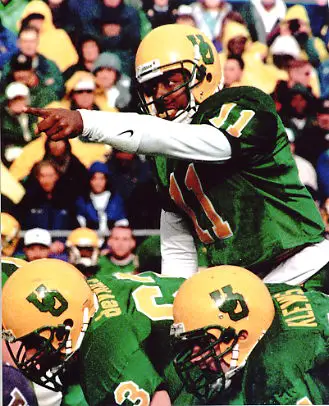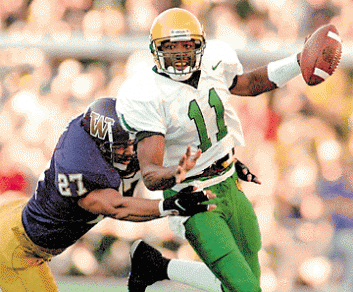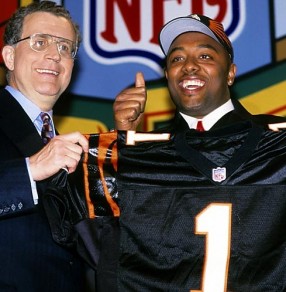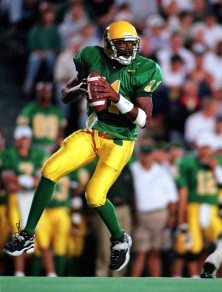 In the years prior to the 1998 season, the Oregon Ducks football team had seen it’s share of exceptional quarterback play. Players like Shy Huntington, Norm Van Brocklin, Dan Fouts, Reggie Ogburn, Chris Miller, Bill Musgrave, and Danny O’neil were some of the notable names generally associated with being regarded as the best in school history at the position. These former greats should be credited for laying a solid foundation and tradition of success, but what Akili Smith accomplished took it all to the next level.
In the years prior to the 1998 season, the Oregon Ducks football team had seen it’s share of exceptional quarterback play. Players like Shy Huntington, Norm Van Brocklin, Dan Fouts, Reggie Ogburn, Chris Miller, Bill Musgrave, and Danny O’neil were some of the notable names generally associated with being regarded as the best in school history at the position. These former greats should be credited for laying a solid foundation and tradition of success, but what Akili Smith accomplished took it all to the next level.
In the preseason, head coach Mike Bellotti had made the decision to start Akili Smith over Jason Maas, after the two had shared playing time the year before. In some of his first year action on the field, Smith had made quite an impression with highlight plays like these:
Even when Akili made a mistake, he could make up for it.
Smith grew up in San Diego where he graduated from Abraham Lincoln (alma mater of Marcus Allen & Terrell Davis) High School in 1993, but was drafted to play professional baseball. Akili played 3 seasons in the Pittsburg Pirates system. However, after testing the waters with a baseball career, he ultimately decided go back to school and play football.
Smith enrolled in Grossmont junior college and starred on the ’95-’96 Grossmont Griffins football team back in his native San Diego area. It was there that the 6’3″ 220lb quarterback caught the eye of the Oregon coaching staff.
At the time, Oregon football was still feeling fresh off of the Rose Bowl, and Cotton Bowl seasons. The team had lost some big names in ’95 and ’96, and there were questions as to whether they would be able to continue this new level of heightened success without Rich Brooks, now head coach of the St. Louis Rams after being named national collegiate coach of the year following Oregon’s improbable run to the Roses during the 1994 season.
Mike Bellotti had been the offensive brains of the operation during the twilight and most successful stretch of coach Brooks’ career at Oregon (1989-1994). Now, it was his time to take the reigns of a budding program, and step out of the shadow of a coaching legend. Bellotti, armed with his calm and controlled persona, high scoring football philosophy, and unflappable moustache, was quick to begin building the program his way. Following Bellotti’s first season (a 10-win year that ended in a Cotton Bowl appearance), the football team experienced a stretch where they improved by one win each year, beginning with the 6 wins in ’96 and ultimately culminating in the 11-1 campaign in 2001.
There was much anticipation coming into 1998 as the new indoor practice facility, the Moshofsky Center, was dedicated in August before the season. The excitement on campus and from fans for the new building was palpable, but the upgrades were likely most welcomed by the coaches and players, as it meant the team no longer had to practice outside in bad weather. Finally, the Oregon coaches had a better answer whenever a top recruit asked “Oregon? Doesn’t it rain a lot there, coach?”
There was also considerable excitement around the athletic ability fielded by the Ducks that year. Across the board, it may have been one of the most talented groups to ever represent the green and yellow. Akili Smith had plenty of help on the offensive side with a run game featuring the dominant Reuben Droughns, the steady Derien Latimer, and the streaky and at times fumble-y Herman Ho-Ching. There were plenty of capable hands to catch passes in Tony Hartley, Damon Griffin, Donald Haynes, and Jed Weaver. The defense was a stout unit with the likes of Rashad Bauman, Steve Smith, Michael Fletcher, Wesly Mallard, Saul Patu, and Peter Sirmon. The Ducks my also have had their best ever kicking tandem with long time NFL punter Josh Bidwell, and the amazing Nathan Villegas, who went a perfect 57-57 on extra points and 20-22 of field goals that year.
To start off the season, the Ducks took on a Big-10 opponent in Michigan State at Autzen stadium. Expected to be a tough early test, the game was anything but. To the delight of the fans in Autzen, the Spartans were no match for the Ducks. They were run over by a powerful Ducks offense and completely controlled by a fired-up defense playing in front of a deafening Autzen crowd. Oregon rolled to a 48-14 victory, and anticipation and expectations began to grow.
Riding a wave of momentum and confidence, the Ducks hit the road to take on the UTEP Miners. In a game that was supposed to be a blowout, Oregon could never quite put the Miners away. In a game marred with mistakes and turnovers, the Ducks escaped El Paso with a 33-26 win, the close call provided an early wake up call.
The next week the team decided to focus all of their efforts on poor San Jose State, who came into Autzen and got blitzed, 58-3. Oregon was hitting an early stride, as the next two games were won handily, 63-28 at home against Stanford and 51-29 on the road at Washington State. The Ducks were cruising along, racking up points and yards with ease. It was the next week however, where one of the most memorable games took place.
Oregon again took to the road for a showdown with UCLA in the Rose Bowl. The two teams battled in an epic game featuring several lead changes and wild swings of momentum. Reuben Droughns had been averaging more than 200 yards rushing per game, but broke his ankle while being tackled near the sideline late after racking up over 175 yards against the impressive Bruins. Droughns immediately ordered his ankle to be taped up so he could return to the game. While this was a display of toughness and dedication to his team, the decision would prove costly.
Now back in the game, Droughns took a handoff and started to the sideline. When he went to cut upfield, the pain of the break became so severe it caused Droughns to fall to the turf clutching his ankle. During the reaction, Droughns fumbled and the ball was recovered by UCLA. It proved to be a mistake the Ducks would not overcome, and they dropped their first game of the season 38-41. A disappointing result sure, but all was far from lost.
The Ducks now sat at 5-1, with a matchup at home against USC looming, and their standout starting tailback now out for the season. The ensuing game was not a pretty one, but the team held together to give coach Bellotti his first career win, 17-13, against the Trojans as a head coach.
With the win, Oregon had secured a bowl bid with 5 games still left to play.
Oregon would travel next to face Arizona and the desert swarm defense, and similar to the UTEP game, the team seemed to be off in every aspect. Arizona’s running game could not be stopped and the Ducks were simply unable to get anything going consistently when they had the ball.  The Wildcats rolled to a baffling 38-3 victory which casted some uncertainty over the remaining schedule. Again, the team would rally following the loss. The Ducks went out and posted a hard fought 27-22 victory over the Huskies, and then blasted ASU 51-19 to give the Ducks a 8-2 ledger going into the Civil War.
The Wildcats rolled to a baffling 38-3 victory which casted some uncertainty over the remaining schedule. Again, the team would rally following the loss. The Ducks went out and posted a hard fought 27-22 victory over the Huskies, and then blasted ASU 51-19 to give the Ducks a 8-2 ledger going into the Civil War.
The Civil War game in 1998 would go down as being among the most entertaining games in the long and storied history of the rivalry. Oregon State had one of their best squads that year, and they were playing at home. Although it may be hard for younger fans to fathom, Parker Stadium was even more of a disasterous eye-sore than modern day Reser.
It may not ever rain in Autzen Stadium, but our pasture grazing friends up north are not afforded the same luxury. The night game was played in cold and rainy conditions that led to standing water at certain spots on the field. A classic back and forth battle unfolded, with Akili leading the way for the Ducks. At one point near the end of the game, the Beaver-believers rushed the field in celebration, only to be reminded that the game was still being played. After clearing all of the sheep-shearers off of the field, the game resumed. Oregon had many chances to put the Beavs away, but could not capitalize, and they came up just short in a 41-44 multi-OT thriller.
After the game, Oregon was selected to participate in the Aloha Bowl against Big-12 opponent Colorado, who were led by the shifty-eyed Rick Neuweisel. Oregon put themselves into a hole early, but nearly came back from a 22-point deficit. In the end, the 43-51 loss was a tough way for such a promising season to end. After the bowl game and the season was over, players, coaches, and fans were left wondering what might have been with a healthy Droughns in the backfield. The depth chart boasted one of the most talented front lines in school history, but Oregon still did not have the quality of depth behind it to maintain the formerly balanced attack of the offense.
Oregon had started the season ranked #24 but climbed as high at #11 and spent 6 weeks ranked in the top 15. The team averaged 39.4 points per game, which was 6th best nationally. For the Oregon football program, the season represented another surge in the rise of the team success and notoriety on the field, and also in the success of recruiting top level athletes.
For Akili Smith, the season meant records. Lots of them. His 3,947 passing yards are still the most ever by a Duck QB by a wide margin. He still has three of school’s top 10 single-game passing outputs, all recorded in the 1998 season. There was the 442 yards passing performance against Washington, 430 in the Civil War, and 456 against Colorado in the Bowl game. His 32 TD passes stood until Darron Thomas threw his 33rd in the Rose Bowl last season.
Akili had a rare blend of arm strength, accuracy, and athletic ability that allowed him to achieve so much in his time as a Duck. He became the first Oregon player to win Pac-10 Player of the year, and was the co-offensive player of the year with UCLA QB and fellow first round pick in the 1999 NFL draft, Cade McNown. The big numbers, wins, athletic ability, and potential earned Smith high marks from the NFL, and he was selected in the 1st round, #3 overall to the Cincinnati Bengals. 
Most Single season Passing Yards, Oregon History
|
Name/Year |
Yards |
Pass Att |
Pass Comp |
Int’s |
TD’s |
Comp % |
|
Akili Smith ’98 |
3,763 |
371 |
215 |
8 |
32 |
58 |
|
Danny O’Neil ’93 |
3,224 |
360 |
223 |
15 |
22 |
61.9 |
|
Bill Musgrave ’89 |
3,081 |
401 |
231 |
16 |
22 |
57.6 |
|
Joey Harrington ’00 |
2,967 |
405 |
214 |
14 |
22 |
52.8 |
|
Darron Thomas ’10 |
2,881 |
361 |
222 |
9 |
30 |
61.5 |
|
Joey Harrington ’01 |
2,764 |
364 |
214 |
6 |
27 |
58.8 |
|
Darron Thomas ’11 |
2,761 |
339 |
211 |
7 |
33 |
62.2 |
|
Jason Fife ’02 |
2,752 |
367 |
190 |
10 |
24 |
51.8 |
|
Tony Graziani ’95 |
2,604 |
426 |
231 |
10 |
13 |
54.2 |
|
Kellen Clemens ’04 |
2,548 |
372 |
223 |
10 |
22 |
59.9 |
|
Chris Miller ’86 |
2,503 |
356 |
216 |
13 |
12 |
60.7 |
|
Dan Fouts ’70 |
2,390 |
361 |
188 |
24 |
16 |
52.1 |
|
Jeremiah Masoli ’09 |
2,147 |
305 |
177 |
6 |
15 |
58 |
|
**Dennis Dixon ’07 |
2,136 |
254 |
172 |
4 |
20 |
67.7 |
Most Single Season Total Offense, Oregon History
|
Name/Year |
Plays |
Rush |
Pass |
Total |
|
Akili Smith ’98 |
453 |
184 |
3,763 |
3,947 |
|
Darron Thomas ’10 |
454 |
486 |
2,881 |
3,367 |
|
Joey Harrington ’00 |
471 |
124 |
2,967 |
3,091 |
|
Danny O’Neil ’93 |
457 |
-137 |
3,224 |
3,087 |
|
Bill Musgrave ’89 |
446 |
-79 |
3,081 |
3,002 |
|
Darron Thomas ’11 |
395 |
206 |
2,761 |
2,967 |
|
Tony Graziani ’95 |
507 |
236 |
2,604 |
2,840 |
|
Joey Harrington ’01 |
419 |
56 |
2,764 |
2,820 |
|
Jason Fife ’02 |
443 |
67 |
2,752 |
2,819 |
|
Jeremiah Masoli ’09 |
426 |
668 |
2,147 |
2,815 |
|
Kellen Clemens ’04 |
490 |
190 |
2,548 |
2,738 |
|
*Dennis Dixon ’07 |
359 |
583 |
2,136 |
2,719 |
|
*Kellen Clemens ’05 |
358 |
228 |
2,406 |
2,634 |
|
Chris Miller ’86 |
430 |
46 |
2,503 |
2,549 |
|
Oregon Football 1998 |
Record 8-4 |
|
Opponent |
Result |
|
MichiganState |
48-14 W |
|
@ UTEP |
33-26 W |
|
San Jose St |
58-3 W |
|
Stanford |
63-28 W |
|
@Wash St |
51-29 W |
|
@UCLA |
38-41 L |
|
USC |
17-13 W |
|
@Arizona |
3-38 L |
|
Wash |
27-22 W |
|
ASU |
51-19 W |
|
@OS(u) |
41-44 L |
|
Colorado-Aloha Bowl |
43-51 L |
Josh White has been a dedicated Duck fan since the Bill Musgrave days. He has attended (and lost his voice at) virtually every home game and many away games since the late 1980’s, including 96 of the current 97 game sellout streak at Autzen Stadium. A Eugene native, Josh works full time in Eugene area real estate, helping people buy and sell residential and commercial properties, and also volunteers with Habitat For Humanity, Kidsports and Food For Lane County. He welcomes your feedback.
Twitter: @WhiteHouseJosh
Facebook: EugenesBestRealtor

